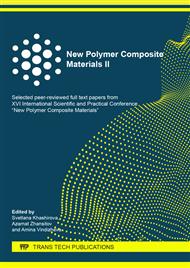p.51
p.56
p.61
p.69
p.76
p.82
p.88
p.93
p.101
Morphology and Mechanical Properties of LDPE, EVA and Fly Ash Composites
Abstract:
The fly ash from Pha Lai power plant was modified by vinyltrimetoxysilan (VTMS). The polymer composites based on low-density polyethylene (LDPE), ethylene vinyl acetate copolymer (EVA) and fly ash (FA) without and with vinyltrimetoxysilan (VTMS) modification were prepared by melt mixing in a Haake Rheomixer. The tensile strength and elongation at break of the LDPE/EVA/VFA composites were also higher than those of the LDPE/EVA/FA composites. The FESEM images proved that FA-VTMS particles disperse more regularly in the polymer matrix in comparison with FA without VTMS modification. In addition, the surface modification of the FA reduced the size of agglomeration of FA particles.
Info:
Periodical:
Pages:
76-81
Citation:
Online since:
October 2020
Authors:
Price:
Сopyright:
© 2020 Trans Tech Publications Ltd. All Rights Reserved
Share:
Citation:


